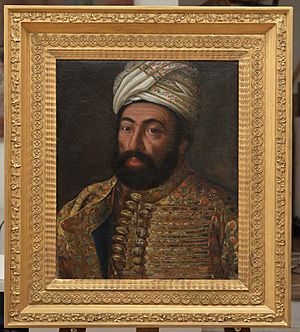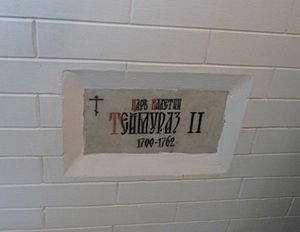Teimuraz II of Kakheti facts for kids
Quick facts for kids Teimuraz II |
|
|---|---|

Teimuraz by Aleksey Antropov
|
|
| King of Kakheti (more...) | |
| Reign | 1732–1744 |
| Coronation | Mtskheta Svetitskhoveli Cathedral October 1, 1745 |
| Predecessor | Constantine II of Kakheti |
| Successor | Heraclius II of Georgia |
| King of Kartli | |
| Reign | 1744–1762 |
| Successor | Heraclius II of Georgia |
| Born | 1680/1700 Tbilisi, Kingdom of Kartli-Kakheti |
| Died | 8 January 1762 (aged 61–62 or 81–82) Saint Petersburg, Russian Empire |
| Burial | Ascension Cathedral in the Astrakhan Kremlin, Astrakhan, Russian Empire |
| Spouse | Tamar Eristavi Tamar of Kartli Ana Baratashvili |
| Issue | Heraclius II of Georgia |
| Dynasty | Bagrationi dynasty |
| Father | Heraclius I of Kakheti |
| Mother | Ana Cholokashvili |
| Religion | Georgian Orthodox Church |
| Khelrtva |  |
Teimuraz II (Georgian: თეიმურაზ II) (1680/1700–1762) was a king from the Bagrationi dynasty. He ruled Kakheti, a kingdom in eastern Georgia, from 1732 to 1744. Later, he became king of Kartli in 1744 and ruled until his death. Teimuraz was also known for writing poems.
Contents
Life of Teimuraz II
Teimuraz was the son of Erekle I and his wife Anna. From 1709 to 1715, Teimuraz and his mother ruled as regents for his brother, David II. A regent is someone who governs a kingdom when the king is away or too young.
In 1732, the Turks killed Teimuraz’s brother, Constantine, who was the king. The Turks then took control of the kingdom. Teimuraz escaped to the mountains of Pshavi and fought against the invaders from there.
In July 1735, the powerful Persian ruler Nader Shah Afshar invaded Kakheti. He drove the Turks out of most of eastern Georgia. Nader Shah called Teimuraz to his headquarters in Erivan. When Teimuraz refused to change his religion to Islam, Nader Shah had him arrested. Kakheti was then put under the rule of Teimuraz's Muslim nephew, Ali Mirza.
In October 1735, Teimuraz escaped to the Kakheti mountains. He started a rebellion against Persian rule, but he was captured again by the end of 1736.
During these years, many Georgian nobles rebelled against the Persian government. In 1738, Nader Shah had to release Teimuraz. He made Teimuraz the governor of Kakheti to help stop the Georgian opposition. At the same time, Teimuraz's son, Erekle II, was fighting with Nader Shah in India.
The uprising turned into a difficult civil war between groups who supported Persia and those who were against it. Teimuraz, with help from his son Erekle II, managed to defeat the rebels led by Givi Amilakhvari. As a reward, in 1742, Nader Shah removed a heavy tax on Kakheti. He also helped Teimuraz take control of the independent areas of Aragvi and Ksani in 1743 and 1744.
For his help against the Ottomans and an uprising against Persia, Nader Shah made Teimuraz king of Kartli in 1744. His son Erekle was given the crown of Kakheti. This helped set the stage for these Georgian kingdoms to unite later. Most importantly, they were recognized as Christian kings. This was the first time since 1632. Both kings were crowned at the Svetitskhoveli Cathedral in Mtskheta on October 1, 1745.
As their power grew, Teimuraz and Erekle soon stopped following Persian rule. Nader Shah ordered 30,000 Persian soldiers to go to Georgia. He put a Georgian convert, Amilakhvari, in charge of this military action. However, Nader Shah was killed in 1747, and his empire fell into chaos. The rulers of Kartli and Kakheti used this chance to remove all Persian soldiers from their kingdoms.
From 1749 to 1750, they stopped several attempts by Persian leaders to gain power in eastern Transcaucasia. They also made the nearby rulers of Yerevan, Ganja, and Nakhichevan pay them tribute. Teimuraz then fought against groups from Dagestan who often attacked Georgian border areas, but he did not fully succeed.
Like some Georgian rulers before him, Teimuraz hoped that the growing Russian empire would protect Christians in the Caucasus from Ottoman and Persian attacks. He sent a group of representatives to St Petersburg in 1752, but nothing came of this visit. In 1760, he visited the Russian court himself. He wanted support for his plan to send a Georgian army to Persia to put a Russian-supported person on the shah’s throne. However, the Russians were too busy with the Seven Years' War to seriously consider Teimuraz’s idea.
Teimuraz died suddenly in the Russian capital on January 8, 1762. He was buried next to his father-in-law, Vakhtang VI, in the Cathedral of the Assumption in Astrakhan. After his death, Erekle became king of Kartli. This united both eastern Georgian kingdoms into one state, the Kingdom of Kartli and Kakheti.
Even though he was often at war, Teimuraz found time to translate works from Persian. He also wrote his own poems and songs, sometimes even while riding his horse.
Reburial
In July 2013, Georgia suggested moving Teimuraz's remains back to Georgia for reburial.
Family
Teimuraz was married three times. He divorced his first wife, Tamar, in 1711. Two years later, on February 2, 1712, he married Tamar (born 1696), the daughter of Vakhtang VI. She died on April 12, 1746. That same year, on August 19, Teimuraz married his third wife, Ana-Khanum (1716 – March 1788). She was the daughter of Prince Bejan Palavankhosroshvili-Baratashvili.
Teimuraz had two sons and four daughters from his second and third marriages.
His children with Tamar of Kartli were:
- Heraclius II (November 7, 1720 – January 11, 1798), who later became king of Kakheti and then of both Kartli and Kakheti.
- Princess Ketevan, who married Adil Shah of Iran (1719–1749) in 1737.
- Princess Elene (active 1743–1784), who married Prince Zaza Tsitsishvili around 1743.
- Princess Ana (1720 – December 4, 1788), who married Prince Dimitri Orbeliani in 1744. After he died, she married Prince Ioane Orbeliani.
Teimuraz's children with Ana-Khanum Baratashvili were:
- Prince Solomon (May 24, 1747 – July 28, 1749).
- Princess Elisabed (March 25, 1750 – May 8, 1770). She was going to marry Prince Giorgi Amilakhvari in 1762. However, the marriage didn't happen for political reasons in 1765. Instead, Elisabed married Katsia II Dadiani, the Prince of Mingrelia, on November 16, 1765.
See also
 In Spanish: Teimuraz II de Kajetia para niños
In Spanish: Teimuraz II de Kajetia para niños


